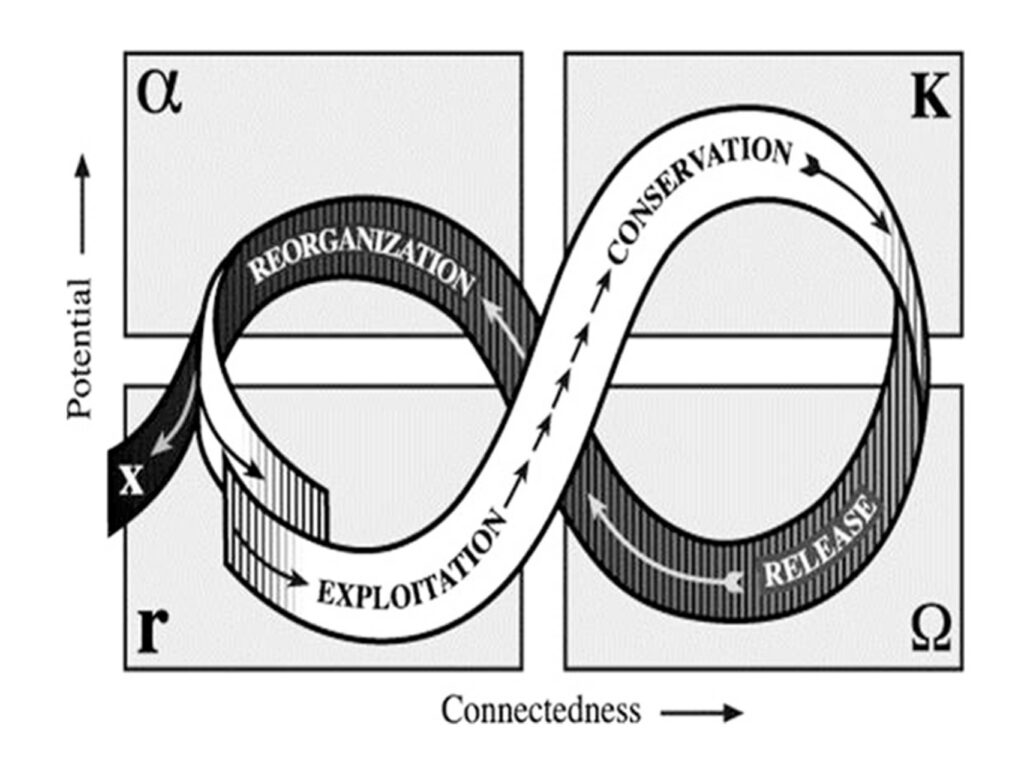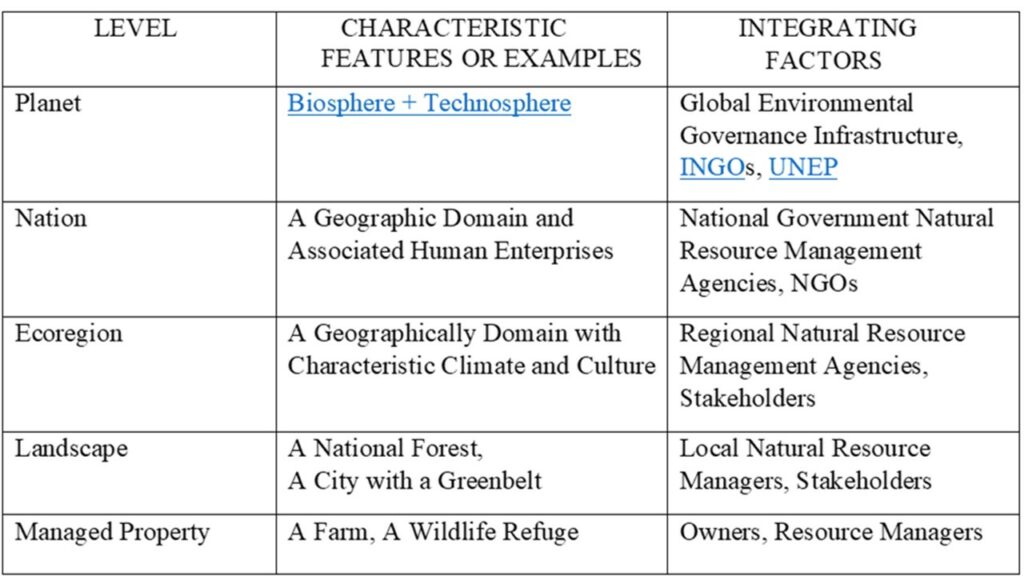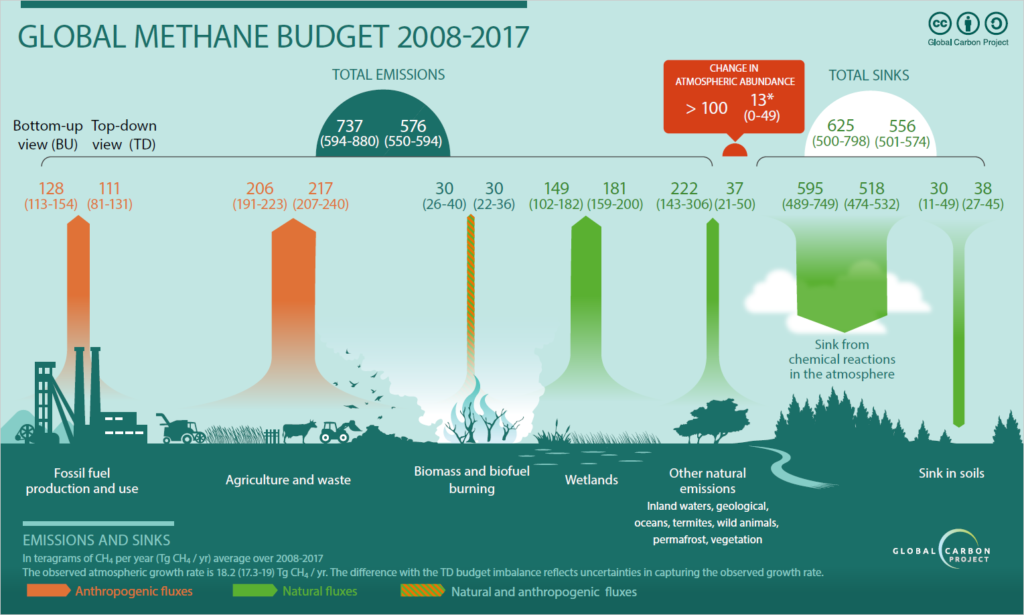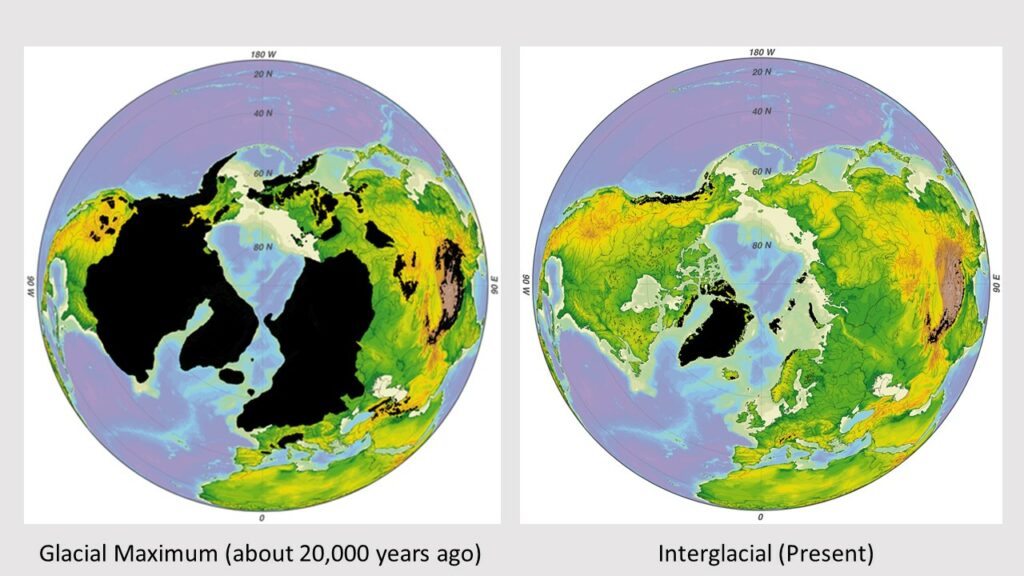
David P. Turner / November 14, 2021
The threat of anthropogenically-induced global environmental change imposes a challenge on humanity to reconceptualize its relationship to the other components of the Earth system. Historically, Nature was the background for the human enterprise. It provided unlimited sources of ecosystem services, such as ocean fish, clean air, and clean water. However, as the human enterprise expanded – especially after the “Great Acceleration” of technological development beginning about 1945 – real limits have become obvious.
Because the sum of human impacts on the environment is now global, humanity as a collective must act to self-regulate. Unfortunately, humanity is not at present a collective, and we are only beginning to construct a worldview that is consistent with living within the biophysical limits of the planet. This post examines three concepts that may help move us towards those goals.
The Technosphere
The term technosphere has been used for decades in the field of Science and Technology Studies and is loosely construed as the sum of all technological artifacts on Earth. Often it is credited with having a degree of autonomy in the sense of its growth having a direction and momentum outside of human control. The current difficulty in reducing fossil fuel related emissions of greenhouse gases is indicative of that autonomy.
In the last decade, the technosphere concept has been more formally defined as:
the set of large-scale networked technologies that underlie and make possible rapid extraction from the Earth of large quantities of free energy and subsequent power generation, long distance, nearly instantaneous communication, rapid long-distance energy and mass transport, the existence and operation of modern governmental and other bureaucracies, high-intensity industrial and manufacturing operations including regional, continental and global distribution of food and other goods, and a myriad additional ‘artificial’ or ‘non-natural’ processes without which modern civilization and its present 7 × 109 human constituents could not exist.
Earth system scientists now make quantitative estimates of the properties of the technosphere such as total mass and annual energy throughput. The juxtaposition of technosphere metrics like global fertilizer use, with biosphere metrics like global nitrogen fixation, reveals the growing dominance of the technosphere in the global biogeochemical cycles and points to the limits to technosphere growth.
The technosphere is in some ways analogous to the biosphere. Both are globe girdling aggregations of quasi-independent subsystems. In energetic terms, both the biosphere and the technosphere are dissipative structures, meaning they capture and use energy to maintain order. The biosphere changes by way of biological evolution; the technosphere changes by way of cultural evolution.
Humans and their institutions are parts of the technosphere, and human thinking is required to organize the technosphere. But the question about technosphere autonomy, and its possible danger to humanity, remains. Notably, the capitalist economic system that underlies the technosphere thrives on growth. Relentless technosphere growth is in effect consuming Earth system capital, such as biodiversity and fossil fuel, that has accumulated over millions of years. Astrobiologists, who ponder evolution of intelligent life on other planets, suggest that an environmentally self-destructive technosphere may significantly limit (filter) how often sustainable high technology planetary civilizations arise in the universe.
A critical problem with Earth’s current technosphere is that due to its rapid and recent evolution, it does not have the kind of feedback loops (as found in the biosphere) needed for self-regulation. Humans are programmed (biologically) to exploit all available resources, but we haven’t evolved culturally to understand limits. Haff emphasizes that the lack of recycling within the technosphere (with the accumulation of CO2 in the atmosphere from fossil fuel combustion as an iconic example). Life cycle analyses of all manufactured products, and better monitoring of input/recycling/output budgets (e.g., for aluminum) at the global scale is required for a sustainable technosphere.
Limitations of the Technosphere Concept
The technosphere concept hints that its structure and function can be shaped by humanity, but there is little sense of economic, political, and legal obstacles to global sustainability. The concept does not capture the reflexive capacity characteristic of human individuals and organizations.
The Noosphere
Russian biogeochemist Vladimir Vernadsky (1863 – 1945) was one of the first scientists to explicitly study Earth as a whole. He understood that the biosphere (the sum of all living matter) added an unusual feature to the planet. The biosphere uses the energy in solar radiation to maintain a new form of order (life) on the surface of the planet. That layer of living matter is a major driver of the global biogeochemical cycling of elements such as carbon, nitrogen, and phosphorus. Vernadsky emphasized that the biosphere was a new kind of thing in the universe, i.e. a step forward in cosmic evolution.
He also recognized that humanity, as a result of the industrial revolution, had become of geological significance. Like the biosphere, humanity and its technology are a product of cosmic evolution – in this case relying upon an organism-based nervous system capable of consciousness and symbolic thinking. By extension from the existing concepts of lithosphere, hydrosphere, atmosphere and biosphere, Vernadsky adopted the term noosphere for this new layer of thinking matter that could alter the global biogeochemical cycles.
The noosphere as conceived by Vernadsky was just getting powered up in his lifetime. He defined it more as a potential transformation of the biosphere – “a reconstruction of the biosphere in the interests of freely thinking humanity as a single entity”.
Vernadsky’s noosphere concept lay mostly dormant for much of the 20th century (although see Sampson and Pitt 1999). Around the turn of the century, Nobel Prize winning atmospheric chemist Paul Crutzen evoked Vernadsky’s idea of transforming the biosphere into a noosphere. But in this 21st century usage, the issue of dangerous human meddling with the Earth system had risen to prominence and the inevitability of a stabilized noosphere was less certain. Similarly, Turner proposed that an updated meaning for noosphere would refer to a planetary system as a whole in which an intelligent life form had developed advanced technology but had learned to self-regulate so as to not degrade the planetary life support system.
In a slightly different take, noosphere is proposed as a paradigm for an era to follow the Great Acceleration. In this case, the noosphere is still imagined as emerging from the biosphere, but here in response to the threats of anthropogenic global environmental change. The maturation of the noosphere would mean the arrival of a global society that collaboratively self-regulates its impact on the Earth system.
Limitations of the Noosphere Concept
As noted, Vernadsky was writing before the scientific discovery that humanity was altering the atmosphere, e.g., by increasing the concentrations of greenhouse gases. Thus, he did not foresee humanity’s possible self-destructive tendencies. His noosphere concept was more about Promethean management of the Earth system than about humanity learning how to self-regulate, which is what we need now.
In most versions of the noosphere concept, the biosphere is “transformed” into a noosphere, hence in its fruition it would physically include the biosphere. However, the biosphere (much of it microbial) will always be capable of functioning independent of human attempts to manage the Earth system. The biosphere could be said to have agency relative to human impacts, which might be a more realistic basis on which to attempt to manage it.
Vernadsky’s noosphere was purely physical, but other users of the term have interpreted it more metaphysically, especially Teilhard de Chardin who referred to a purely spiritual endpoint of noosphere evolution. This spirituality and teleology have made the noosphere concept aversive to many scientists (see Medawar in Sampson and Pitt 1999).
The Global Brain
About the same time (1920s) that the noosphere meme was fostered by Vernadsky, Teilhard de Chardin, and Le Roy, the concept (or metaphor) of the global brain also emerged. Novelist and futurist H.G. Wells (1866 – 1946) proposed that all knowledge be catalogued in a single place and be made available to anyone on the planet. His hope was that this common knowledge base might lead to peace and rapid human progress. Given that World War II was soon to erupt at the time of his “World Brain” proposal, Wells was clearly ahead of his time.
Like the noosphere concept, the World Brain concept was not much referred to in the decades following its origin in Well’s imagination. However, the late 20th century Information Technology revolution has reinvigorated discussion about it. With rapid build out of the global telecommunications infrastructure, the global brain has begun to be envisioned as something wired together by the Internet.
Systems theorist Francis Heylighen and his collaborators at the Global Brain Institute have devoted considerable attention to building the analogy between the human brain and a proposed global brain, especially in relation to the process of thinking.
Heylighen sees the global brain as a necessary part of an emerging social superorganism – a densely networked global society. His global society will coalesce because information technology now offers a growing proportion of the global population access to a wealth of information and an efficient way to organize production and consumption of goods and services. Rather than totalitarianism, the high level of connectivity in Heylighen’s model of the social superorganism stimulates individuals to develop themselves (while still acknowledging membership in a global collective). This model leads to more distributed, less hierarchical, power centers.
How the global brain will think is not well characterized at present. Cultural evolution has always been a form of collective intelligence and the binding power of the Internet now provides a forum for a global collective to exchange ideas (memes). Changes in the frequency distribution of search term or web page usage would be one means of monitoring global thinking.
Collaborative development of the Community Earth System Model is an example of collective thinking on a limited scale. Specialist scientists work to improve the many subsystems of the model, and periodically the computer code is updated based on a consensus decision.
One other intriguing analogy relates to a characteristic feature of the human brain in which it makes frequent (conscious or unconscious) predictions. If they are not fulfilled, a motivation to act may be instigated. With Earth system model scenarios now produced in the context of climate change assessment, the global brain might also be said to be constructing scenarios/predictions for itself. Comparisons of scenarios, or detection of discrepancies between favorable scenarios and how reality is playing out, could inspire corrective action by the global collective.
Limitations of the Global Brain Concept
The analogy of global brain to individual brain is certainly a stimulant to conceptualizing new global scale structures and processes. However, since we barely understand our own consciousness and decision-making processes, it is an analogy that still needs a lot of work, especially with respect to the executive function. In the near-term, humanity needs research and models on how to integrate governance among 8-10 billion people (i.e. what form of institutions?) and how to convince billions of planetary citizens to cooperate in the effort that humanity must make to self-regulate. The global brain concept does not facilitate the coupling of the human enterprise to the rest of the Earth system.
Conclusions
The technosphere, noosphere, and global brain concepts share a common concern with understanding the relationship of the burgeoning human enterprise, including its technology, to the entirety of the Earth system. Anthropogenic global environmental change poses an existential threat to humanity and there is a clear need for a Great Transition involving massive changes in values as well as technology. These three concepts serve as beacons pointing towards global sustainability.
The utility of the technosphere concept is that it refers to measurable entities, and formally meshes with the existing Earth system science paradigm. Given that humans are only part of the technosphere, and a part does not control the whole, awareness of the technosphere argues against hubris. However, the technosphere concept doesn’t engage the host of psychological and sociological issues that must be addressed to rapidly alter the Earth system trajectory. It helps reveal the danger humanity faces but doesn’t foster a worldview that will ameliorate the danger.
The chief utility of the noosphere concept is its cosmic perspective and aspirational quality. A weakness is ambiguity about what the noosphere includes and how it operates.
The utility of the global brain concept is that it confirms we have the technical means to actualize global collective intelligence, which will be required to deal with the overwhelming complexity of the Earth system. A weakness is a limited model of global governance and a lack of attention to the rapid erosion of the human life support system (the biosphere) that must function well for the emerging global brain to flourish. The capacity of individuals to know themselves, i.e. to reflect on their own behavior and its consequences, can potentially be scaled up to the global human collective. This process will depend on the communication possibilities opened up by the Internet.
The technosphere, noosphere, and global brain concepts will contribute to synthesizing a new model of the planetary future that includes a functioning global society and a technological support system that maintains a sustainable relationship to the rest of the Earth system.


















